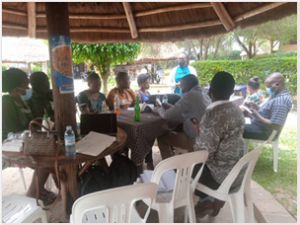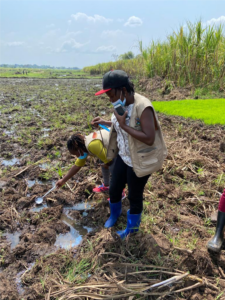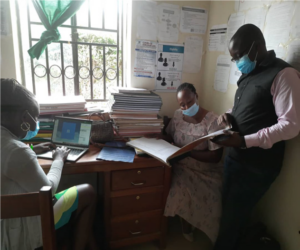 |
Dr Patience MwineMBChB (Mak), MPH (Mak), Field Epidemiology Fellowship (UPHFP) Host Site: STI/AIDS Control ProgramHost Mentor: Miss Juliet Cheptoris, Dr Joshua Musinguzi |
||||||
ABOUT THE FELLOWPatience holds a Master of Public Health from Makerere University with a background in human medicine. She joined the Public Health Fellowship Program in 2020. During the fellowship, she was attached to the STI/AIDS Control Program (ACP) where she supported the HIV prevention arm of Adolescent Girls and Young Women (AGYW) Program. During this time, she performed large dataset analyses, scientific writing and presentations, project designing and implementation, participated in high level national meetings, coordination of training and mentorship activities, review and editing national documents, responded to various disease outbreaks to mention but a few. Outside her host site, Patience participated in various outbreak investigations. These engagements have greatly built her capacity and complemented the skills and experience she had achieved from my previous trainings. With this fellowship, she has the ability to serve in any capacity with a spirit of excellence and a great sense of leadership as an epidemiologist. Achievements at the Host Site
Fellowship program specific achievements
Conference presentations
Written communication
Lead author o “Readiness of Health Facilities to Manage COVID-19, Uganda, June 2021” Submitted to the Health services BMC Journal for peer review and publishing. o “HIV positivity and recent rates among Adolescent girls and young women aged 10-24 years in Uganda 2017-2021”. Undergoing review by the resident advisor. o “SGBV among adolescent Girls and young women during the main COVID-19 period in Eastern region ”.Undergoing review by the resident advisor. Co-authored o Barriers and facilitators to retention in HIV care for persons on community differentiated service delivery (DSD) models in Uganda, 2021 o Malaria Outbreak in Nabitende Subcounty, Iganga District, Uganda 2021 o Investigation of Jiggers Outbreak, Sheema District, Uganda 2022
o Readiness of health facilities to manage the second wave of COVID- 19,Uganda, June 2021 o HIV positivity and recency rates among Adolescent Girls and Young Women, 2017-2021, Uganda.
Skills/ Lessons learnt During the fellowship, I learnt and developed the following skill sets:
Summary of Epidemiological Study:Title: Readiness of Health Facilities to Manage COVID-19 in Uganda, June 2021 Patience Mwine1*, Immaculate Atuhaire1, Benon Kwesiga1, Daniel Kadobera1, Sherry R. Ahirirwe1, Hilda T. Nansikombi1, Shaban Senyange1, Sarah Elayeete1, Veronicah Masanja1, Alice Asio1, Allan Komakech1, Rose Nampeera1, Edirisa J. Nsubuga1, Petranilla Nakamya1 Andrew Kwiringira1, Stella M Migamba1, Lillian Bulage1, Paul E. Okello1, Sandra Nabatanzi2, Fred Monje1, Alex R. Ario1, Julie R. Harris2 1 Uganda Public Health Fellowship Program, Ministry of Health, Kampala, Uganda 2 Centers for Disease Control and Prevention, Kampala Uganda *Correspondence: Patience Mwine, +256702449738, pmwine@musph. ac.ug Background: The COVID-19 pandemic has overwhelmed the capacity of health facilities globally, emphasizing the need for readiness. The first wave of COVID-19 in Uganda peaked in late 2020, uncovering challenges with facility readiness. In mid-2021, we assessed the readiness of health facilities in Uganda to manage the second wave of COVID-19. Methods: We assessed 17 RRH and 71 lower-level health facilities from all subregions of Uganda during June 2021. In each of the facilities, we interviewed the director about challenges faced during the first COVID-19 wave. We inspected COVID-19 treatment units (CTUs) and other facility service delivery points using a WHO observational checklist with infection prevention, equipment, medicines, personal protective equipment (PPE) and CTU surge capacity. We used the “ReadyScore’’ criteria to classify level of preparedness as >80% (‘better prepared’), 40–80% (‘work to do’), and <40% (‘not ready’). Readiness was assessed using facility-level-specific parameters. Results: All 17 RRH assessed were managing COVID-19 patients at the time of the visit. Of these, 15 (88%) were in the “work to do” category, and two (12%) were “better prepared”. Most 13 (82%) had an inadequate supply of essential medicines, 12 (71%) lacked oxygen, and 11 (65%) lacked space to expand CTUs. Fifty-five (77%) of the 71 lower-level health facilities assessed were “not ready”, and 16 (23%) were in the “work to do” category. Seventy (99%) lacked medicines, 64 (90%) lacked PPE, and 53 (75%) la Conclusion: Few health facilities were ready to manage a second wave of COVID-19 in Uganda during June 2021. The largest gaps were in essential medicines, PPE, oxygen, and space for CTU expansion. Adequate preparedness for future waves of COVID-19 requires additional support and action in Uganda Keywords: COVID-19, Preparedness, Second wave, Health facilities, Uganda Key lessons learnt during the fellowship
|
|||||||
|
|
|
|
|



